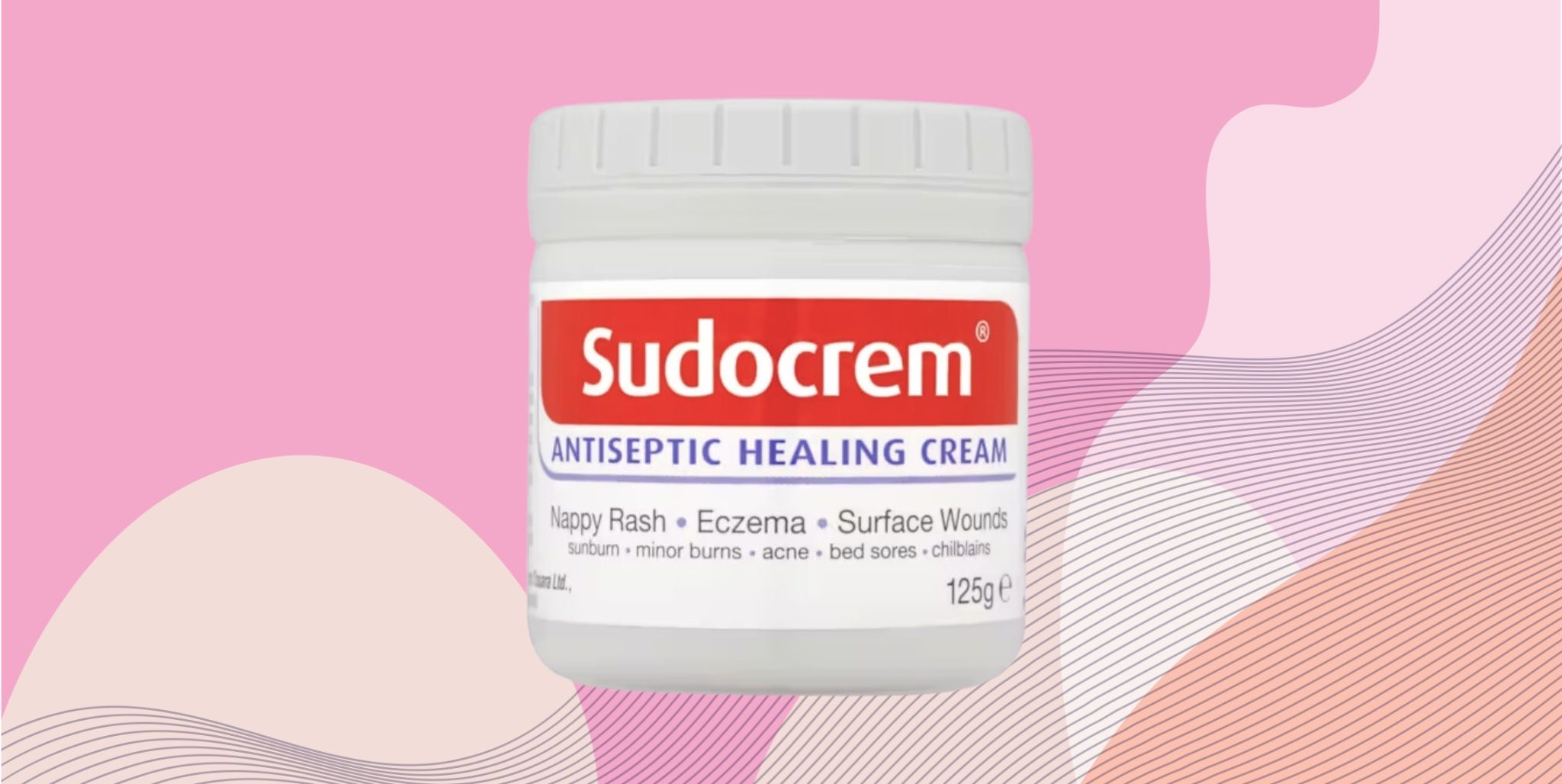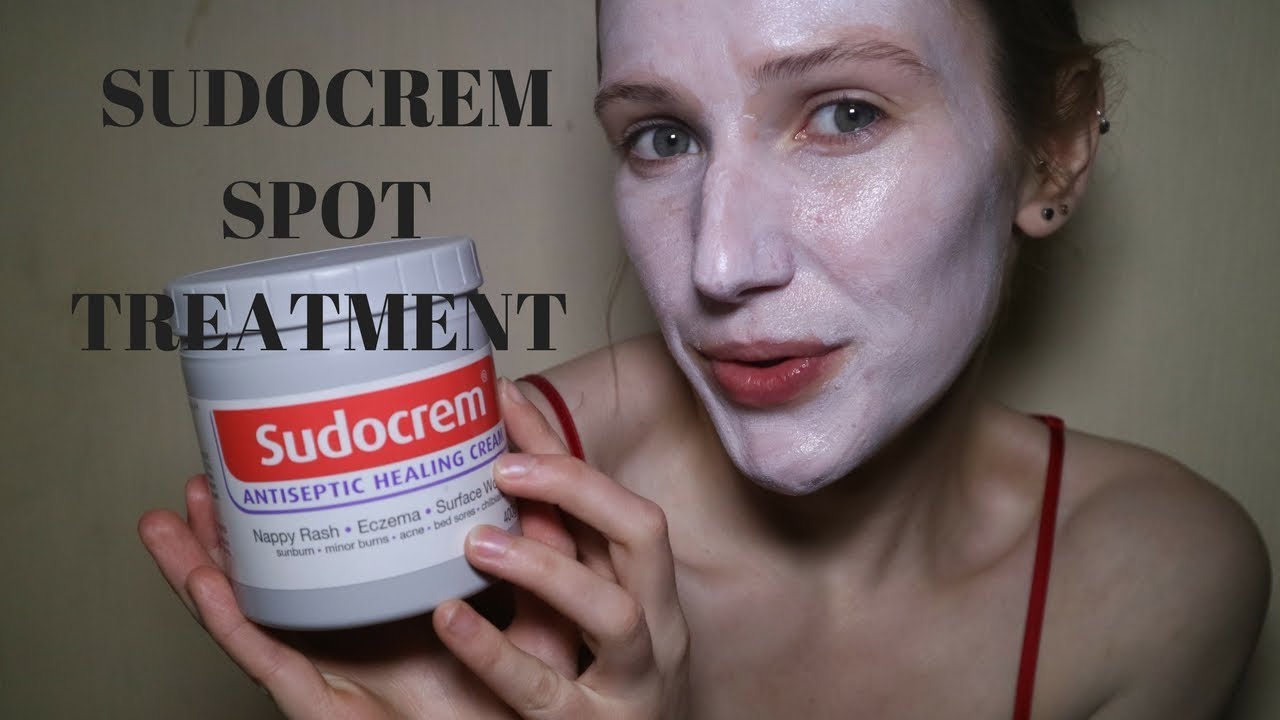To use Sudocrem for acne, apply a small amount directly onto the affected area before bedtime. Gently rub in the cream using clean fingers to form a thin layer.
Sudocrem, traditionally used for diaper rash, has become a go-to for acne sufferers. The cream’s zinc oxide content helps reduce inflammation and redness, while the antibacterial properties can assist in preventing infection. A thin application on spots or blemishes can work overnight, promoting healing and soothing irritation.
Remember to wash your hands before and after application to keep bacteria at bay. This method, integrated into your nightly skincare routine, can be an effective part of managing acne. Always conduct a patch test first to ensure no adverse reactions occur, and consult with a dermatologist for persistent or severe acne issues.

Credit: www.womenshealthmag.com
Sudocrem: A Surprise Ally Against Acne
Think of acne solutions, and your mind might not picture Sudocrem first. Yet, this soothing cream is gaining attention for its acne-fighting properties. Sudocrem, traditionally used for diaper rash, has become a go-to for skincare enthusiasts. It’s an over-the-counter secret that can tackle troublesome spots. Let’s explore why Sudocrem could be the unexpected hero in your acne care routine.
The Active Ingredients In Sudocrem
- Zinc oxide: Reduces inflammation and dries out acne.
- Lanolin: Moisturizes and soothes the skin.
- Benzyl alcohol: Has local anesthetic and antiseptic properties.
- Benzyl benzoate and benzyl cinnamate: Help heal the skin.
These key components work in unison to calm redness, ease swelling, and promote healing. Sudocrem’s formula does more than just treat diaper rash; it’s a multitasker that addresses acne symptoms effectively.
How Sudocrem Differs From Traditional Acne Treatments
Unlike many acne treatments, Sudocrem is gentle on the skin. It doesn’t contain harsh chemicals that can strip the skin’s natural oils. This means it’s less likely to cause irritation or dryness. The cream’s protective barrier also shields sensitive skin from irritants. Sudocrem’s unique approach to healing acne is through soothing and restoring the skin’s balance, not just fighting the acne bacteria.
| Sudocrem | Traditional Acne Treatments |
|---|---|
| Targets inflammation and redness | Focus on killing acne-causing bacteria |
| Maintains skin’s moisture | Can strip skin’s natural oils |
| Minimal risk of irritation | Possible side effects like dryness and peeling |
For those with sensitive skin or looking for a gentler acne solution, Sudocrem may be the ideal choice. Its mild formulation and healing properties can soothe skin while keeping acne at bay.
Acne Basics: Causes And Common Treatments
Struggling with acne can feel like an uphill battle. It’s not just a teenage issue; adults face it too. Before diving into solutions like Sudocrem, understanding acne is crucial. Let’s explore what causes those pesky pimples and the typical ways people try to say goodbye to them.
The Science Behind Acne
Acne starts in our pores. These tiny openings can trap oil and dead skin. Sometimes, bacteria join the party, causing swelling. Hormones and genetics play big roles too. When pores get clogged, pimples pop up.
- Oil production: Glands in your skin make oil, which can clog pores.
- Dead skin cells: They can build up and block pores.
- Bacteria: Germs can infect clogged pores, leading to redness and swelling.
- Hormones: Changes, especially during puberty, can increase acne.
Standard Acne Treatments And Their Limitations
Many treatments promise clear skin. Some work; some don’t. Let’s peek at the common ones and their drawbacks.
| Treatment | How It Works | Limitations |
|---|---|---|
| Over-the-counter creams | They target bacteria and reduce oil. | May irritate or dry out skin. |
| Prescription meds | Doctors prescribe stronger drugs. | Can have side effects and high costs. |
| Natural remedies | Includes tea tree oil and aloe vera. | Results vary and can take time. |
Every skin is unique. What works for one person may not work for another. It’s about finding the right balance and treatment that suits your skin type.
The Magic Of Zinc Oxide In Sudocrem
Welcome to the secret world of Sudocrem, where zinc oxide is the star player. This common diaper rash cream might just be the unexpected hero for those battling acne. Let’s dive into the wonders of zinc oxide in this iconic cream.
Zinc Oxide’s Role In Skin Health
Zinc oxide is a mineral known for its powerful skin-protecting properties. In Sudocrem, it works wonders by creating a barrier on the skin. This barrier protects against irritants and moisture, which can exacerbate acne issues. Zinc oxide also has anti-inflammatory properties, reducing redness and irritation. It’s not just a barrier creator; it’s a skin soother too.
- Reduces skin oiliness
- Calms inflamed acne
- Minimizes pores and prevents clogging
Clinical Evidence Supporting Zinc Oxide For Acne
Studies have consistently shown zinc oxide’s effectiveness against acne. It’s not just old wives’ tales; there’s science behind Sudocrem’s acne-fighting claims. Research suggests that zinc oxide can help reduce the severity of acne and improve skin health.
| Study | Results |
|---|---|
| Zinc oxide as an acne treatment | Participants saw a significant decrease in acne severity |
| Long-term use of zinc oxide | Reported ongoing improvement in skin clarity |
With its ability to fight bacteria, soothe inflammation, and regulate oil production, zinc oxide in Sudocrem might just be the gentle, effective solution for acne-prone skin. Remember to patch test and use as directed for the best results.

Credit: www.womenshealthmag.com
Applying Sudocrem Correctly For Maximum Effect
Discovering the best way to use Sudocrem for acne is a game-changer. This popular cream, known for its healing properties, can help reduce redness and soothe skin. Proper application ensures maximum effectiveness in your battle against breakouts.
Step-by-step Guide To Applying Sudocrem
- Clean your skin with a gentle cleanser to remove impurities and excess oil.
- Pat your skin dry with a clean towel. Avoid rubbing, as it can irritate acne.
- Use a clean fingertip or cotton swab to apply a small amount of Sudocrem directly onto the affected area.
- Spread the cream thinly over the blemish, creating a light layer that covers it completely.
- Leave the Sudocrem on overnight, or for a few hours, to allow it to work its magic.
- In the morning, rinse off any remaining cream with lukewarm water.
- Follow up with a non-comedogenic moisturizer to keep skin hydrated.
Tips To Avoid Common Application Mistakes
- Do not overuse the cream; a thin layer is enough.
- Avoid covering your entire face with Sudocrem. Target only the acne spots.
- Wait for the cream to dry before getting into bed to prevent it from rubbing off onto your linens.
- Use Sudocrem sparingly and not as a daily acne treatment.
- Don’t mix Sudocrem with other acne treatments without consulting a dermatologist.
Integrating Sudocrem Into Your Skincare Routine
Integrating Sudocrem into Your Skincare Routine can help tackle acne effectively. Sudocrem, known for its healing properties, can soothe inflamed skin. It’s a multi-tasking cream that targets redness, swelling, and bacteria. For those struggling with breakouts, Sudocrem might be the missing piece in your skincare puzzle. Let’s explore how to incorporate this versatile cream into your daily regimen for clearer skin.
Best Times To Apply Sudocrem
Timing is crucial when adding Sudocrem to your skincare routine. Apply it at night for best results. Your skin heals while you sleep, making it the perfect time for Sudocrem to work its magic. Cleanse your face thoroughly before application. Dab a small amount of Sudocrem on the affected areas. Leave it overnight and rinse it off in the morning with warm water.
Complementary Skincare Products
Using the right products alongside Sudocrem can enhance its benefits. Stick to gentle cleansers to avoid irritation. After cleansing, apply a water-based moisturizer. This helps to maintain hydration without clogging pores. Once the moisturizer is absorbed, you can apply Sudocrem to the targeted areas. Always use sunscreen during the day to protect your skin from harmful UV rays. Below is a list of product types that work well with Sudocrem:
- Gentle cleansers: to clean without aggravating acne
- Water-based moisturizers: to hydrate without adding oil
- Non-comedogenic sunscreens: to shield skin from sun damage
Real Results: Testimonials And Before-and-after Stories
Exploring the transformative journey of individuals who’ve battled acne can be incredibly inspiring. Real results speak volumes, and nothing showcases the efficacy of a product better than authentic testimonials and before-and-after stories. It’s time to delve into the personal experiences of those who have used Sudocrem to combat their acne woes.
Success Stories From Real Users
Countless individuals have turned to Sudocrem as a trusted ally in their fight against acne. Real-life success stories abound, with many users experiencing significant improvements.
- Jane’s Journey: “After two weeks, my skin cleared up remarkably!”
- Mark’s Milestone: “Sudocrem reduced my redness and swelling overnight.”
- Emily’s Experience: “Consistent use has made my acne scars fade.”
Photographic Evidence Of Sudocrem’s Effectiveness
They say a picture is worth a thousand words, and this rings especially true for before-and-after acne treatment photos. Check out these compelling visual stories that track the progress of real users over time.
| Before | After | User Feedback |
|---|---|---|
 |
 |
Lucy: “It’s incredible to see my skin now versus a month ago.” |
 |
 |
Alex: “My acne cleared up, and my confidence soared!” |
 |
 |
Sam: “Seeing the change in my skin has been life-changing.” |
When To See A Dermatologist
Exploring at-home remedies like Sudocrem for acne is common. Yet, there are times when professional help is crucial. Recognizing the signs that it’s time to consult a dermatologist can make a significant difference in your skin’s health.
Signs Your Acne Might Need Professional Intervention
Acne varies in severity, and not all cases respond to over-the-counter treatments. Here are signs that indicate it’s time to seek a dermatologist:
- Persistent acne that doesn’t improve with standard treatments.
- Severe inflammation or deep, painful cysts and nodules.
- Acne that leaves scars or dark spots on your skin.
- Emotional distress or reduced self-esteem due to skin issues.
What To Expect From A Dermatologist Appointment
Booking an appointment with a dermatologist is a proactive step towards clearer skin. Here’s what to anticipate during the visit:
- A thorough skin examination to assess your acne’s condition.
- Detailed questions about your skin care routine, diet, and lifestyle.
- Possible skin tests or lab work to rule out underlying conditions.
- A customized treatment plan that may include prescriptions or procedures.
- Guidance on how to care for your skin to prevent future breakouts.
Remember, your skin is unique. Professional advice can make a world of difference. Don’t hesitate to book that dermatologist appointment if you notice any concerning signs with your acne.
Sudocrem And Sensitive Skin: A Gentle Approach
Managing acne can be a delicate task, especially with sensitive skin. Sudocrem, known for its soothing properties, offers a gentle solution. This section explores how Sudocrem can be a friend to those with a sensitive complexion.
Benefits For Those With Sensitive Skin
Sudocrem isn’t just a diaper rash cream. It’s a versatile treatment ideal for sensitive skin types prone to acne. Here are its key benefits:
- Zinc oxide reduces redness and inflammation.
- Lanolin helps to protect delicate skin.
- Antiseptic properties combat acne-causing bacteria.
Together, these ingredients help manage breakouts without harsh effects.
Managing Potential Skin Irritation
Even products for sensitive skin can sometimes cause irritation. Here’s how to use Sudocrem safely:
- Start with a patch test to check for reactions.
- Apply a thin layer on affected areas only.
- If redness or itching occurs, stop use immediately.
By following these steps, you can help ensure a positive experience with Sudocrem for acne.
Contraindications And Precautions
Contraindications and Precautions are critical when considering Sudocrem for acne treatment. Sudocrem, known for its healing properties, can be an effective remedy. Yet, certain conditions and skin types may not respond well to its ingredients. It is essential to know when to step back and what potential side effects may arise.
When To Avoid Sudocrem
Not everyone should use Sudocrem on their skin. Be cautious if you have the following:
- Known allergies to Sudocrem components.
- Broken skin or open wounds near acne.
- Severe cystic acne; a doctor should advise you.
Consult a healthcare provider before applying Sudocrem if you are pregnant or breastfeeding.
Understanding Potential Side Effects
Sudocrem is generally safe, but side effects can occur:
| Side Effect | Description |
|---|---|
| Redness | Skin may appear red post-application. |
| Itching | An itch could develop on the treated area. |
| Rash | Small bumps or a rash might form. |
Stop using Sudocrem and seek medical attention if side effects persist or worsen.

Credit: www.womenshealthmag.com
Enhancing Your Diet For Better Skin Health
Enhancing Your Diet for Better Skin Health is a key step when tackling acne. Sudocrem can be an effective topical treatment, but what you eat plays a crucial role too. A balanced diet can help reduce inflammation and promote clearer skin. Let’s explore how.
Foods To Eat And Avoid For Acne-prone Skin
Choosing the right foods can help manage acne from the inside out. Focus on these groups:
- Fruits and vegetables: Rich in antioxidants and vital nutrients.
- Whole grains: They maintain stable blood sugar levels.
- Lean proteins: Such as fish and tofu, reduce skin inflammation.
- Healthy fats: Avocados and nuts support skin health.
Avoid these to prevent acne flare-ups:
- Dairy products: They can trigger hormones that lead to acne.
- Refined sugars: They spike insulin and can worsen acne.
- Fried and fast foods: These may increase oil production in your skin.
The Role Of Hydration And Nutrition In Skin Care
Hydration is vital for flushing out toxins that may cause acne. Aim for:
- Water: At least 8 glasses a day to keep your skin hydrated.
- Herbal teas: They can help reduce inflammation.
Nutrition also plays a significant role. Vitamins like A, D, and E support skin health. Zinc helps heal and rejuvenate the skin. Include foods rich in these nutrients for optimal skin care.
Long-term Acne Management And Care
Acne troubles many people well beyond their teenage years. Sudocrem can be a helpful ally in your fight against acne. But remember, it’s not just about the occasional spot treatment. Long-term skin health involves more than just a cream. It’s about a holistic approach to prevent breakouts before they begin.
Lifestyle Changes For Acne Prevention
What you do every day affects your skin. Small changes can make big differences. Here are some lifestyle tweaks for clearer skin:
- Eat balanced meals rich in fruits, vegetables, and lean proteins.
- Stay hydrated with plenty of water to flush out toxins.
- Reduce stress through activities like yoga or meditation.
- Get enough sleep to allow skin to repair itself.
- Avoid touching your face to reduce the spread of bacteria.
Building A Sustainable Skincare Regimen
Alongside lifestyle changes, a consistent skincare routine is crucial. Here’s how to build one that lasts:
- Cleanse gently twice a day to remove impurities.
- Apply Sudocrem to affected areas to soothe and protect.
- Moisturize daily to maintain skin barrier health.
- Use sunscreen to protect against harmful UV rays.
- Exfoliate weekly to clear dead skin cells.
Remember, consistency is key. Give your skin time to adjust to new products.
Faqs: Clearing Up Common Misconceptions About Sudocrem
Acne troubles many people, and Sudocrem might be a surprising helper. But, there are myths about its use. This section focuses on FAQs to clear up these myths about Sudocrem for acne.
Debunking Myths About Sudocrem
Myth 1: Sudocrem can cause more acne. This is not true. Sudocrem has ingredients that help soothe the skin, reduce redness, and fight bacteria.
Myth 2: It’s only for babies. Wrong! Adults can use Sudocrem for acne because of its healing properties.
Myth 3: Use it all over your face. Too much can clog pores. Spot treatment is best.
Answers To Frequently Asked Questions
- Can Sudocrem clear acne overnight? No, it can help reduce redness and swelling, but it’s not a quick fix.
- How often should I apply Sudocrem? Once or twice daily on the affected area is enough.
- Is Sudocrem a moisturizer? No, it’s a protective barrier cream with additional healing properties.
| Question | Answer |
|---|---|
| Should I use it on open acne? | Wait for the skin to heal slightly to avoid irritation. |
| Can it remove acne scars? | It’s not proven to remove scars but may help reduce their appearance. |
Frequently Asked Questions
Can I Put Sudocrem On My Face Every Night?
Yes, you can apply Sudocrem on your face every night, but use it sparingly and target only problem areas to avoid clogged pores.
How Do You Use Sudocrem Properly?
Clean and dry the affected area. Apply a thin layer of Sudocrem gently. Use it as often as needed. Remember not to rub it in vigorously. Keep the cream away from the eyes.
How Long Does Sudocrem Take To Work?
Sudocrem typically begins showing results within 24 hours of application, with significant improvement often noticeable after a few days of consistent use.
Does Sudocrem Heal Acne Scars?
Sudocrem can help soothe acne-inflamed skin, but it’s not specifically formulated to heal acne scars. Its primary use is as an antiseptic healing cream for minor cuts and burns.
Conclusion
Embracing Sudocrem for acne management can be a game-changer. Its antibacterial properties help soothe and heal blemishes effectively. Remember, a small dab goes a long way—use it as a spot treatment overnight for the best results. Consistency and patience are key to clearer skin.
Give Sudocrem a try and witness its benefits for yourself!

